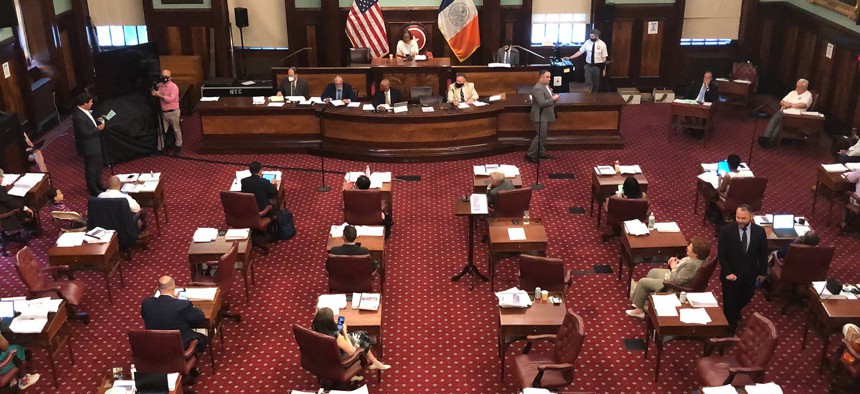The financial struggles of New York City caused by the coronavirus pandemic felt like a distant memory Wednesday as New York City Mayor Bill de Blasio and New York City Council Speaker Corey Johnson announced an agreement on a $98.7 billion budget, the biggest in the city’s history. “This is one of the greatest investments in working families in the history of New York City,” de Blasio said in the City Hall rotunda, ahead of the Council’s vote on the budget. “We are sending resources to the communities that need it most.” The press conference was sealed with the traditional “budget handshake” and then a hug between the two leaders who are both term-limited out of their positions at the end of this year. It was the first major in-person event at City Hall since the beginning of the pandemic in March 2020, and it was followed by the first meeting of the City Council at City Hall in 16 months. The Council has been meeting remotely since the pandemic began. Here are four things to know about the budget, which was passed on Wednesday afternoon just hours before the beginning of the new fiscal year on July 1.
The city is flush with federal cash.
About $16 billion of the budget is funded directly by COVID-19 aid money from the federal government, according to the Citizens Budget Commission. That meant this budget season featured none of the belt-tightening rhetoric that we’ve heard in recent years. Instead the focus was on new spending, like $15 million devoted to the Universal NYC Baby Bonds program, which will give at least $100 towards a college savings account to every kindergartner in city public schools this fall. The money also allowed the city to grow its reserves to $5.1 billion, including $1 billion in the city’s new Rainy Day Fund. The budget-savings hawks at the CBC were pleased, commending it as a great first step towards saving more, but de Blasio credited Council members for pushing for it. “I’ve been at this a long time,” he said. “I’ve not met a group of people who cared more about adding to reserves than this group here.”
The NYPD was not defunded
In fact, the New York City Police Department’s expense budget is about $200 million higher than last year’s budget, with increases split among spiking overtime costs and information technology upgrades, de Blasio said. That doesn’t quite make up for the approximately $382 million cut to the budget the year before, when criminal justice reform advocates launched a massive campaign calling on the city to shift at least $1 billion of the NYPD’s approximately $6 billion budget towards other services like health care and neighborhood violence prevention initiatives. The movement made the same ask this year, but it didn’t pick up steam like last year, when marches against racism and police brutality dominated the news. This year, there’s a notable increase in shootings and murders in New York City, and talk of increasing police seemed to dominate the recent mayoral race. Still, NYPD funding was at least one of the reasons why four more progressive Council members voted no on the budget. “New York City already has more police officers per capita than nearly every large American city,” Council Member Brad Lander, who appears to have a lead in the race to be the next City comptroller, wrote as part of a lengthy statement. “In this moment, we should instead be investing more in other strategies for genuine community safety.” The progressives were joined in their no votes by two of the Council’s Republicans: Steve Matteo and Joe Borelli.
Much of the new spending focused on education and schools
Budget documents weren’t made available to reporters until the last minute, so much of our knowledge of the budget is based on what de Blasio and Johnson presented in press releases and at the press conference. A fuller picture of the city’s spending will likely be revealed in the coming days and weeks, but what was clear on Wednesday was that much of the city’s new spending was focused on education initiatives. “A big part of our recovery means investing in our students and young people, and this budget does that. ... For the first time ever, every school will receive 100% of their Fair Student Funding,” Johnson said to cheers. “We are also going to make sure that every school has a social worker… We are investing in smaller class sizes and a new literacy curriculum to address learning loss from a lack of in-person instruction.”
A major labor union was disappointed
District Council 37, a major labor union that represents city employees, released a statement from its president Henry Garrido on Wednesday morning saying the union was “incredibly disappointed that the city will not move forward with its early retirement incentive,” which would offer buyouts for certain city employees. “Our members who have given decades to this city are receiving only disrespect. We will not forget.”
Those were strong words for de Blasio, who has generally been an ally to the union, but he brushed them off at the press conference. “Now we see COVID rapidly on the decline but the need for recovery to be very intense. It’s in the interest of the people of New York City to stick with what we’ve got now,” he said. “We do not want to see a lot of veteran members of our workforce actually being incentivized to leave just when we need them.”


